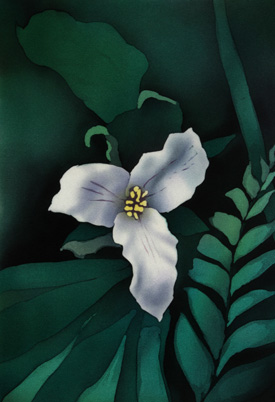


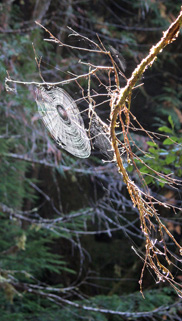




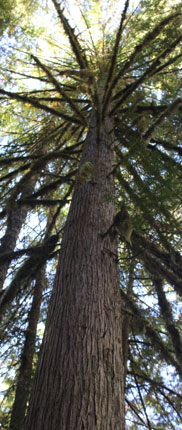

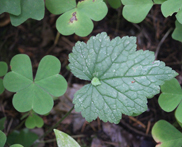
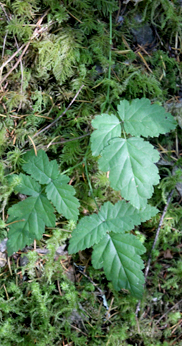
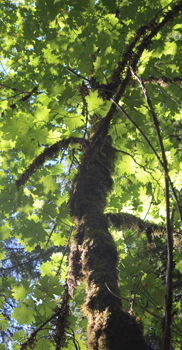
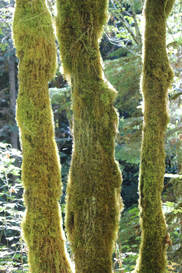
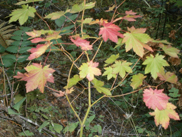
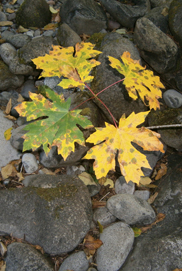
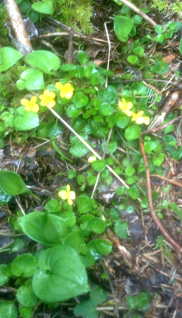
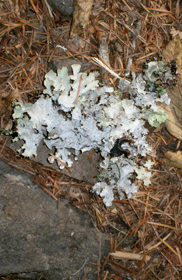

Essay by Barry Lopez, Aug 4, 2014 THE CASE FOR GOING UNCIVILIZED In the half-century since the Wilderness Act was passed, almost everything has changed. All the more reason to go wild. Dawn light, mouse gray in the woods. Gazing north into the trees through the bedroom windows, I can see hours of daylight waiting for me. Time for a recalibration walk. I’ve been living in my head too long. I’ll wait a few hours, then call my young friend Tyson, a wilderness ranger with the Forest Service. I’ll suggest we hike in to a place like Quaking Aspen Swamp or some other, similar corner of the Three Sisters Wilderness Area. I find it safer these days to have a companion on such walks, and he’s good company. He knows how to say nothing. I’ve got to get up and check the weather. As an eight-year-old, growing up in agricultural Southern California, I thought the eastern Mojave Desert wilderness enough for me. It raised the hair on my neck. Years later, I need to walk the extra miles, get clear of any sign of human habitation, the pervasive and intrusive spoor of the mechanized world. But those early days in the Mojave, not so far from the road, fixed something in me, an unquenchable desire to immerse myself in landscapes still owned by their resident animals. A conviction that to attach myself in these places will offer me, yet again, a way to examine what human life—any life—means in an era of cell-phone-triggered bombs and residual aquatic Prozac. In the years since I coursed through creosote flats in the Mojave as a boy, inhaling the tangy aromatics ballooning outward from those bushes after a rain, I’ve been lucky. I’ve found my way into some of the planet’s least civilized scapes—diving under the ice in McMurdo Sound in Antarctica, descending into canyons in the Pilbara, in Western Australia, traveling the north coast of Alaska in a small boat. Such places offer a kind of illumination that can take the darkness out of contemporary life. You can feel the relief, once the tinnitus starts to fade, and you begin to move gracefully down the trail instead of headlong, pausing often now to reconnoiter, the way every other creature does. I remember the extended pleasure I felt as a temporary resident in those places, the hours of mental clarity and exuberance. The memories always make me want to go out the door again, hopeful of regaining the sense of balance that the persistent closeness of strangers, the screech and mumble of machinery, and the needling presence of advertising threaten, every day, to overturn. Daily life devours the equanimity that unmanipulated land can restore—if one is patient, hungry, respectful, and willing to be vulnerable. When Tyson picks up the phone, I tell him I’m wondering about hiking into Wolverine Meadow later this morning, in the Three Sisters—partly out of respect for this indomitable animal, now rumored to be back in the area. Sorry to disappoint, he says, but the road to that trailhead is still snowed in. Why not try the French Pete Creek trail, he says, which takes off at a lower elevation? Hike up the valley until snow stops us, or till high meltwater in the creek shuts us out of the upper valley. Fine by me, I answer. It’s raining fitfully now, and showers are forecast for the rest of the day, but it doesn’t occur to me to reconsider. Tyson never brought it up either, of course. It’s spring in the western Cascades. My house sits about 13 crow-fly miles from the western boundary of the Three Sisters Wilderness, but I haven’t been up French Pete Creek in a while. When Tyson suggested we go, I recalled images from my first hike up there, in 1970. It’s gorgeous, innocent country. As I stage a few necessities in my daypack, I recall the 800-year-old cedars there, remember bull trout, now threatened, in the creek and ripe salmonberries and huckleberries by the trail. I recall spotting an obsidian arrowhead, just the tip, gleaming in the duff. Mostly, though, I recall the days of protest. In the run-up to the passage of the landmark Wilderness Act in 1964, the fight to protect French Pete Creek in Oregon’s Willamette National Forest catalyzed and defined an emerging, nationwide argument about wilderness policy. By 1954, the struggle to keep road building and commercial logging out of this ten-mile-long, 19,000-acre valley—an effort that began in the late 1930s—had developed into what some believe was the country’s first citizens’ campaign to protect a specific wilderness area. The push to include French Pete Creek valley (and two adjacent watersheds, a total of 45,400 acres) in the Three Sisters Wilderness extended through several campaigns, near successes followed each time by defeat. Eventually, however, cut-and-run logging interests, long deferred to by the Forest Service, found themselves facing off in court against a politically astute group of new-line conservationists, social activists, and political progressives, people who rejected the historically more timorous approach of old-line groups like the Friends of the Three Sisters and the Sierra Club.
When the Wilderness Act established protection for the Three Sisters in 1964, the effort to include French Pete was still being contested. It took until 1978, with the passage of the federal Endangered American Wilderness Act, for French Pete (collectively, the drainages of Walker, French Pete, and Rebel creeks) to finally become part of the 281,190-acre Three Sisters Wilderness. The strategy for preserving French Pete differed fundamentally from earlier conservation efforts. It didn’t rely on arguments that appealed solely to aesthetic values; instead it employed a strategy based on cost-benefit analysis and on evoking a sense of outrage among ordinary citizens over the timber-industry-friendly management of federal lands. In the late sixties and early seventies, this largely ethics-based approach to evaluating undeveloped areas resonated strongly with many advocates for social change in America. The Wilderness Act had stripped the Forest Service of the power it once had to designate wilderness areas, turning it over instead to Congress, where citizens had the right to actively participate in the process. In essence, though the establishment of a new order on federal forestlands would take time, activists striving well into the seventies to protect French Pete broke the back of the timber industry, which had grossly underestimated the strength of its adversaries’ arguments. Driving up to French Pete that day to meet Tyson, I could look back on those days of protest and feel some measure of satisfaction. On November 18, 1969, I stood in front of Willamette National Forest headquarters in Eugene with a crowd of about 1,500 protesters, denouncing with them the Forest Service’s defiant, ongoing effort to open French Pete to logging. The demonstration was not a reiteration of Mobilization Day, the Vietnam moratorium protest that had taken place in Washington, D.C., just three days prior, but the Eugene crowd was animated by similar convictions, among them a belief that theirs was a just cause of national importance. They also believed that if the federal government succeeded in handing French Pete over to the logging industry, the country’s fundamental integrity likewise would be called into question. The industry, of course, never got the timber in French Pete, but the fight against corporate greed, ethical compromise, special-interest land management, and excessive development hasn’t ended. We enlighten each other; we heal our wounds; and the young take to the walls yet again—with great courage, great effort, great faith. Then, for a few more years, we feel blessed.
Walking up French Pete Creek with Tyson, I’m staggered by beauty on every side. Hundreds of small deer’s-head orchids are blooming lavender and fuchsia in a jungle of green hues on the forest floor: thimbleberry thickets, tussocks of sword ferns in their fiddlehead stage, salal and Oregon grape, woodland strawberries, vanilla leaf, nodding stems of Solomon’s seal, tuffets of bear grass. We’ve not walked 100 yards and already I’ve lost the desire to go on. I’d be fine here for a week. Gentle rain, light winds, errant shafts of sunlight piercing the forest canopy where fires crown, and the crash and roar of the bounding creek, all coming at once, so occupy the ear and eye that my bare hands, with their sensitivity to temperature, to the texture of tree bark and the strike of rain, bring me information for which there is hardly room. But I bend down to palpate the difference between the serrated edges of leathery Oregon grape leaves and the waxy, ovate foliage of salal. I reach out to feel the prickling needles of spring growth on yew branchlets and the supple, spatulate leaves of Indian plum. I sense wild ginger and bleeding heart are close by but can’t spot them.
The white blossoms of trillium, a kind of lily, have by now darkened to shades of magenta and are melting like colored tissue in the rain. We’re still weeks from hawthorn blossoms, blue huckleberry fruit, pale pink trumpets blaring in the rhododendron thickets, nuts bedded in spiny bracts on the chinkapins, native blackberries ripening along with yellow-orange salmonberries. Tyson, in a phrase new to me, refers to the red, black, and yellow flares on some individual Oregon grape leaves, vivid before us now in the wet, as “Rasta colors.” We examine the flank of a rotting red cedar, gutted by a black bear. We pause where an elk trail crosses ours—several animals, the hoofprints maybe an hour old. Everywhere we look we see fresh animal sign—where deer have snipped tree buds; where gray squirrels have torn the seeds from hundreds of Douglas fir cones, leaving the protective cone scales in heaps; where tailed frogs have left their toe impressions in the soft mud of a rain puddle, sheltered from wind and the pelt of rain. The bear grass is far from sending its plumed stalk up into blue summer skies canopied over the clearings in summer, but dogwoods are already in chalk white blossom. Bull trout are savaging insect larvae in the creek, devouring them out of earshot; turkey vultures are circling out of sight somewhere above, hoping for a glimpse of a carcass, a half-finished cougar kill, a gray fox dead of a heart attack. Sheets of mist slipping sideways on bursts of wind roil ten thousand infant leaves on vine maples against a chiaroscuro sky, an Impressionist furze and yet one more shade of green, this a pale one, leaning to yellow. When sunlight strikes them, the sheen of their wetness makes them seem lit from within. In the understory are still other greens: jade and celery, apple and shamrock, the celadons and malachites. In the canopy above, bottle and deep blue-greens, the greens of emeralds. I can find these same hues at my home, where spring wildflowers are rioting this afternoon, where tree frogs croak at dusk, and where from the kitchen I’ve watched bobcat, mink, and others pass on their indecipherable errands. So the question arises: Why make this effort to hike the French Pete trail, which this afternoon so bewitches me? It’s because even in my home forest, only lightly disturbed by man, I cannot feel as sharply, mile after mile, the intensity of untrammeled, the extent of undeveloped, the amplitude of natural, the starkness of solitude, the classic goals of wilderness management. On this trail, I feel more acutely the defeat of my culture’s manic appetite for raw materials, its yearning for profit, its impatient refutation of numinous life outside the human. It’s here that I feel, instantly and relentlessly, the uncomplicated air pushing against my skin, and know, as the late poet John Haines once wrote, that we are “the guests of a barely understandable host.” The path we follow will eventually arrive at a creek crossing, and we will have to make a decision about whether I can cross. I’m older than when I first walked here. Arthritis now cramps my hips and lower spine, and my sense of balance is failing. I can’t anymore bolt, quick as a goat, over stretches of exposed river rock or run gracefully across chaotic terrain. I have to take my time. This does not embarrass me or make me feel inferior to the task. Like every animal in these woods, I’m adapting. I’m playing the cards I’ve been dealt and not wondering who took the cards I once held. The year the Wilderness Act went into effect, I was a 19-year-old wrangling horses on pack trips into the Teton Wilderness in Wyoming. All these years later, I’m still glad to be stunned, stopping to slide my fingers down the sidewalls of an elk’s hoofprint, edging head and shoulders out into the currents of air tumbling over the creek to inhale the ozone. French Pete Creek is, I need to say, an ordinary kind of western Oregon valley. No scenic vistas, no charismatic megafauna—the wolves and grizzlies are gone. No spectacular groves of old growth, though there are some very old, fire-scarred Douglas firs scattered about, and the ancient cedars are here. No towering waterfalls to gawk at, though the creek is a nearly unbroken run of cascading, pellucid water, cavitating wildly around basalt boulders, a cacophony without letup. To step in here, to sense the canopy closing over you a hundred feet above, the finger-laced crowns of hemlocks, firs and cedars, black cottonwood and big-leaf maple, to feel that fluid life force, thundering over the creek bed like horses crashing a chute, vibrating in your thighs, to look down at a trail that shows no sign of hard use, to absent yourself for a day from landscapes vulgarized by billboards, to run your arms into the duff beyond your wrists and then plunge them deep in the fulminating creek, is to open yourself to what 13th-century architects wanted to happen to you when you entered Chartres or Notre Dame. Before we reach the river crossing, Tyson and I descend from the trail toward the creek to dismantle a fire pit where someone once camped, perhaps several years ago, to judge from the thickness of a pelt of moss the color of absinthe that has established itself over the ashes. “No fires within 100 feet of the trail,” the regulations say. We scatter river cobbles and the half-burned stobs of wood, dust the ground with maple leaves, and go on up the trail. The medallion of brilliant moss gleams back there like a winter moon but looks like it belongs. Like us, I suppose. Art Director's Note
Editor's Note
|
|||||||||







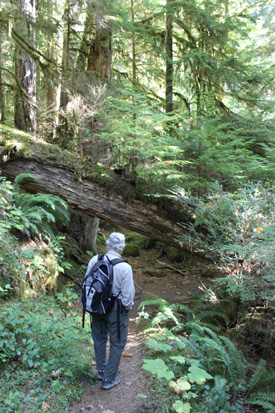
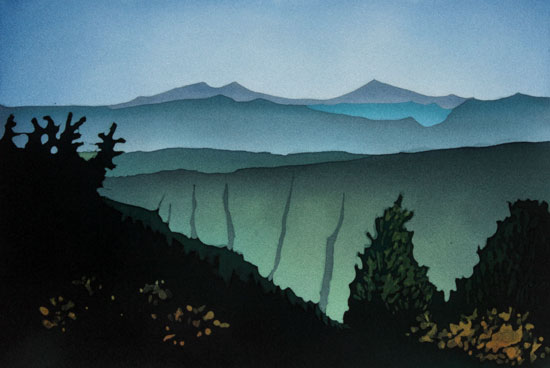
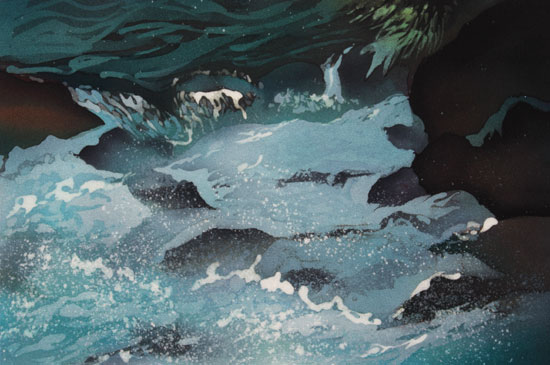
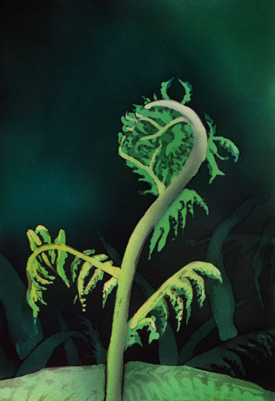 Fiddlehead, Dorothy Bowen, rozome on kimono silk
Fiddlehead, Dorothy Bowen, rozome on kimono silk 